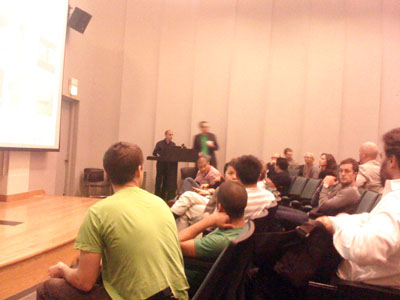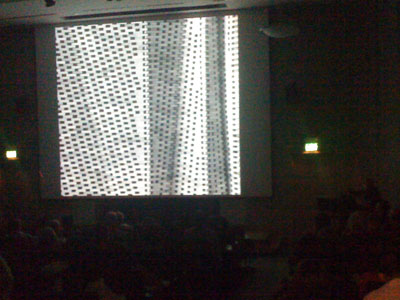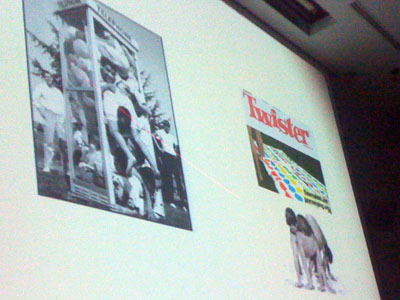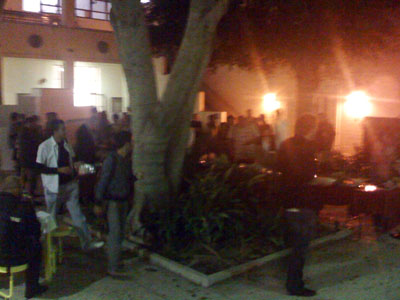
I went to the Nader Tehrani (Office dA) lecture at USC tonight, but due to the twin LA curses of traffic and parking, I was about 20 minutes late. Who knows what goodies I missed! What I did catch of the lecture was an impressive array of projects with a clear thread of a similar sensibility in regard to materiality and process throughout. One major theme that kept coming up was the use of simple geometric profiles parametrically shifted into other simple geometric profiles to create a deformable unit used throughout the project in different iterations to create a dynamic whole. I definitely hadn’t realized that this concept was used in the only built Office dA project I’ve visited, the
Helios House BP gas station in LA. Each vertical member is apparently built from the same unit, distorted to form column, paystation, and “sign-less signage” (his term for the wide panel section facing the street that though it doesn’t technically have signage, helps “transform the brand into environment”). I was also heartened to see that he devoted a whole section of the lecture to installation projects that conceptually were very similar to the unit/connection/agglomeration projects we’ve been working on in studio. He even used some of the same language we’ve been using to describe our work. His projects were clearly different as they were actually realized at a human scale, and responded to different constraints; but otherwise they were very similar in that they used a very simple unit (wood slats, wood veneer rectangles, and laser cut folded panels) with primacy placed on dynamic connections and the agglomeration of units responding to site constraints. He referred to many of these projects as “irrelevant” or as “failures”, but productive ones. Clearly they’re more productive than irrelevant, or I’m sure he wouldn’t include them in lectures.

His work seems to embody some of the best qualities of a lot of current architects, including interest in a very contemporary kind of materiality, in parametric shift operations to generate form, and in creating skins and volumes that respond to program. I’m basically a sucker for this kind of work, and was very impressed with what was presented. But the one thing I didn’t like about Tehrani’s presentation is that it was difficult to engage with as he spoke almost solely in contemporary archi-theory-speak. I wish I had transcribed a quote to use as an example, but I’m sure you know what I’m talking about. I can get into that kind of discourse sometimes, and often it really is the best way to talk about what are very complex topics. I’m not asking everyone to present work
as accessibly as Bjarke Ingels, but I feel like I’m at a level where if it’s a struggle for me to understand what someone is talking about, their archi-speak functions more as obfuscation than elucidation, the latter of which I feel should be one of the primary objectives of public lectures like this. That said, Mr. Tehrani is clearly very smart, and operating on a very elevated level, and is even producing excellent work despite this, ha ha. I did appreciate the few moments of humor and levity he introduced, notably when he showed a bunch of 50’s football players crammed into a phone booth and said it was an example of how “the contents not interested in the envelope”, and then pulled up on the same slide an image of the Twister game logo, followed by a picture of naked men on a twister board under a caption of something like “Bob’s Naked Men Twister” or something like that. To which he said something to the effect of “we are not interested in the telephone booth, more in the Twister”. From what I gathered, I don’t think he’s saying he likes porn (or not JUST saying that, ha ha), but rather he's using bodies as an example of how a system can be constructed that allows the contents to inform the envelope. Apparently the “envelope” around sweaty man bodies, ha ha ha. Nice one, Nader.
 The good slide
The good slide
Even if he has to couch it in theory speak, I would have enjoyed seeing more about how his work engages more performatively (in the sense of human performance rather than technical performance), as this is one of my areas of interest. This was only alluded to again (that I noticed) at the very end of the lecture when he was discussing the obligatory “cool bathroom” in a Boston restaurant they did where small tubes allow tightly controlled views and aural interactions between the mens and womens restrooms.
In the very limited Q&A session after the lecture he seemingly loosened up a little bit, at least enough to admit that despite his rhetoric seeming to say that intense theoretical and programmatic investigation informs every move of the design process, his projects are actually unapologetic about the authorship of the designer, and that they “try to construct inevitability, effortlessness, and ease”. That’s the kind of candidness I appreciate, and I would have enjoyed hearing that theme expanded on, as it seems to be trendy now to admit that no, the computers don’t do everything; designers are allowed to make choices.
Also, there was a reception in the USC Architecture building's courtyard afterward. I didn't really talk to anyone, hence doing a pretty bad job of promoting inter-school relations, but I did take the opportunity to graze at the very impressive buffet laid out. But where was the booze?! You USCers need to talk to your administrators about that.
 Nice courtyard; nicer spread!
Nice courtyard; nicer spread!
I knew about this lecture as part of the USC fall lecture series, but I didn’t realize that it acts as a kind of kick off to a very interesting conference at USC on Friday and Saturday. The conference is called “Materials Matter”, and Friday especially looks fantastic: Peter Zellner is moderating a panel with one of the instructors I first learned Maya from in undergrad at the School of the Art Institute of Chicago; my current studio instructor Jason Payne is moderating a panel with Heather Roberge; and first year studio faculty Georgina Huljich is speaking with her partner Marcelo Spina from Patterns. The day ends with a lecture by the principals of Iwamoto Scott, one of the only SF architecture firms worth shaking a stick at (what does that saying mean, anyway?). Here's a
pdf link to the schedule. The only catch is that I have to get there by 8 am to catch the first session. To say this will be “tough” for me is a pretty major understatement. Fortunately, they have free coffee and snacks in the morning, which is always a good motivator. Hopefully I will post on the interesting tidbits from the conference tomorrow, but if I don’t, you’ll know I slept through the whole thing.





5 Comments
"contents" is not necessarily content.
I like the work. A lot of it looks like it came out of a Rhino or 3d Max plug-in or extension. Masonry isn't the material for it but, rather, something that a cad/cam machine could make.
take a break man. spend an evening at liquid kitty or the other room. there is more to LA than architecture...
Ha ha believe me, I know! But I had two years to enjoy LA - now's the time to burn bridges with all my non-arch friends!
ICON magazine recently did an article about Office dA.
I thought this was a fitting quote in the context of your post.
"Office dA aims to liberate the boxed-in Swiss as well as reign in the formalism of the likes of Frank Gehry. It’s a testament to the practice’s lofty ambition, but it’s easy to get lost in the language and rhetoric that surrounds it – Tehrani’s rampant theorising of everything can be exhausting: “Microdisciplinary advances… the speculative spirit of academia… intellectual stimulation... complexity of plot…a more discerning form through practice.”
See the rest here
http://www.iconeye.com/index.php?view=article&catid=413%3Ajune-2008&layout=default&id=3484%3Aoffice-dA&option=com_content
Block this user
Are you sure you want to block this user and hide all related comments throughout the site?
Archinect
This is your first comment on Archinect. Your comment will be visible once approved.